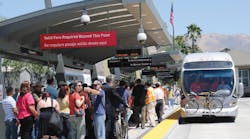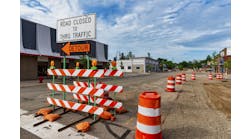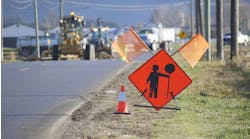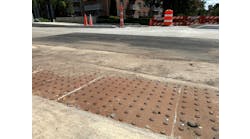This summer the Los Angeles County Metropolitan Transportation Authority (Metro) opened a 4-mile extension of the popular Metro Orange Line dedicated busway in the San Fernando Valley, northwest of downtown L.A.
It provides a much-needed north-south link between Warner Center—the third largest employment center in L.A. County—and the Amtrak and Metrolink commuter rail station in Chatsworth. It also provides the first frequent-service connection between Los Angeles and the Ventura County exurbs to the west.
The Orange Line Extension is 4 more miles of bus rapid transit (BRT), four stations, three park-and-ride lots with more than 1,000 spaces, beautiful public art and a bike-and-pedestrian path surrounded by drought-tolerant landscaping.
It has proved to be a world-class BRT transit solution. Although BRT is not appropriate everywhere, it is clearly the right tool for this particular corridor. Among the reasons BRT was selected: It is less expensive to build than light rail, surface space for the Orange Line was available—something not always the case in dense urban areas—and it could be built quickly (in three years) and so was capable of assisting a heavily trafficked corridor sooner rather than later. Not long after it opened, the University of California-Berkeley studied the Orange Line’s impact on existing traffic congestion and determined that within months, it had benefited the traffic-packed parallel Ventura (101) Freeway.
Clearly, the Orange Line is working. The public has flocked to it and the brand new extension. When the Orange Line opened in 2005, 7,000 to 8,000 boardings a day were predicted. Average weekday boardings are now about 27,000. And with the new Orange Line Extension, Metro is expecting an additional 9,000 boardings by 2030. Also expected are 45,000 boardings on the entire busway by 2030.
Extending the engineering
“We learned a few things from the first stretch of Orange Line, we made a few changes and we added a few new ideas,” said project manager Hitesh Patel.
Portions of the first 14-mile stretch of Orange Line were built on a rubberized asphalt surface. However, this pavement did not perform well under the weight of heavy loads from 60-ft articulated buses that can carry a crush load of 100 passengers. The current busway is covered with asphalt, except near intersections, where the heaviest bus braking occurs. In those areas concrete is used for additional strength and durability.
Another modification for the extension was that busway widths were increased by 2 ft to provide more space for buses and their side mirrors to pass each other without conflict. Approaches to bypass lanes at stations were lengthened to improve potential future express service. Station canopies were modified to include energy-saving LED lights, improve aesthetics and reduce maintenance.
But perhaps the greatest challenges for the Orange Line Extension—as for all transit projects—were those connected with safety.
“No matter what we do, we’re always thinking about safety for our employees, for our construction workers, for our future passengers, for the people who will interact with our lines,” Patel said. “We live and breathe safety, and that served us well on this project, as well as on others.”
One of the major safety challenges for the Orange Line Extension was keeping buses, trains, cars, pedestrians and bicyclists separated at a point where all merge, just south of the Amtrak, Metrolink and new Metro Station in Chatsworth.
This merge issue was mitigated by construction of the Lassen Street Bridge, an overpass that carries the busway over a street and rail tracks to eliminate interaction between buses, trains and cars. But the Lassen Street Bridge presented a variety of major design and construction challenges.
A pile of concrete
Among the most significant challenges was designing a 500-ft, three-span, cast-in-place, prestressed box-girder busway bridge at a skewed angle relative to the tracks and constructing it in a very tight space between active Amtrak and Metrolink passenger rail and Union Pacific freight tracks, Lassen Street and extensive major communications and power utilities. All of this needed to be done without disturbing adjacent residential and commercial properties, without disrupting rail and street traffic and while maintaining the highest safety standards.
The bridge, which is over the active railroad and with complex angles created by the bridge diagonal, is supported by a single column and an abutment very close to the tracks. The column is supported by 13.5-ft-diam., cast-in-drilled-hole concrete piles—the largest diameter pile built at the time of construction. The pile, weighing nearly 150,000 lb, required two of the largest cranes available just to lower the cage into the hole. Also, an innovative pressure-grouting technique, a first in California, was used to reduce the length of pile to within the constructable length of 80 ft.
Another major issue was that overhead power and communication lines conflicted with bridge construction. To enhance safety and visual impact, these major utilities were relocated inside ducts placed under Lassen Street, an at-grade rail crossing and a nearby bridge. One-hundred-fifty-ft borings of 42-in., 36-in. and 24-in. diam. were completed under the at-grade rail crossing using a boring/jacking machine located in a 24- × 15-ft jacking pit, without impacting a significant number of major existing utilities, complicated by the presence of large boulders.
In addition, some major design changes were necessary due to differing site conditions. During drilling for the cast-in-drilled-hole piles for the bridge, large rocks were encountered that required a complete redesign of the foundations to larger-diameter piles that would allow extraction of the rocks through use of a large auger with a wider flight path.
It was necessary to construct a smaller 145-ft Los Angeles River bridge using a precast girder system to expedite construction and minimize impact on the existing waterway. Work was complicated by underground large storm drains that limited the locations of the foundations.
Another design challenge was fitting the busway and accompanying bikeway between Metrolink railroad tracks and Canoga Avenue, a secondary highway, without acquiring or impacting private property. This problem was solved by performing studies to convince Metrolink to realign about 3?4 mile of track and convince the city of Los Angeles to waive its requirement to widen Canoga Avenue and to actually slightly reduce the width.
Where paths intersect
Safety is of utmost importance when building any Metro project. During the first months of the original Orange Line operation in 2005, a number of accidents occurred in which motorists ran through red lights and hit the buses. It was Metro’s goal to avoid a repeat.
Intersections were the issue. With that in mind, a number of tools are being utilized to enhance safety for Metro operators and passengers, as well as for motorists and pedestrians navigating the streets and sidewalks around the busway:
- All busway crossings are signalized with protected left- and right-turn arrows across the busway to control traffic and pedestrian bike movements across the busway. No uncontrolled movements are allowed;
- Programmable visibility signal heads are used to avoid driver confusion;
- Extended all red signal timing slot clearance ensures that crossing areas are clear;
- Flashing “Bus Coming” signs with a picture display of a bus alert motorists, pedestrians and bicyclists to an approaching bus;
- Upgraded train signals and crossing gates were installed at the existing at-grade crossing of the railroad tracks and Lassen Street, beneath the busway overpass;
- Red-light cameras, in-pavement lights and special pavement markings (“Bus Only,” “Keep Clear,” “Bus X-ing,” “Look Both Ways” and “Wait Here”) are being used to elevate awareness; and
- Intersections are being closely monitored, and adjustments will be made where needed to improve safety.
Another innovation, already in use for other Metro BRTs, is transit-priority technology. This technology includes special transponders mounted on all buses that emit signals to a series of wired loops embedded in the pavement. As a bus passes from one loop to the next, the data is sent to a centralized computer in downtown Los Angeles. This data is then used to determine the bus speed and location. Based on the bus speed and location, the data predicts when the bus will arrive at the next signalized intersection and determines whether to extend the green light or shorten the red. It also provides bus-arrival information for passengers, as well as check-in and check-out detection. All of this occurs in a matter of seconds.
Sustainable busway
Transit projects by their nature are sustainable. But Metro is always looking for ways to utilize green techniques when building. That is why bioswales and bioretentions were constructed along the Orange Line Extension busway and parking lots. A bioswale is a special eco-friendly drainage ditch filled with vegetation. When it rains, polluted water drains into it from the busway and bikeway. The bioswale decreases the amount of water discharged into the storm drains, since some of the water is absorbed by plants and some naturally flows into the soil. Also, the water that does flow into storm drains—and ultimately into the ocean—is cleaned by the vegetation before doing so.
Other green techniques along the extension include the use of solar power and LED for lighting and irrigation piping, which is ready for reclaimed water when it becomes available.
The $215 million Orange Line Extension project came in far ahead of schedule. Original projections were for 2016 completion. Instead, it opened this June both because of excellent project management and because of the passage in 2008 of Measure R, the half-cent sales tax for transportation, which allowed construction to begin sooner than planned.
Of huge importance at this time of tight funding, the extension was completed significantly under budget. Final costs have not yet been tallied, but Metro is estimating that the total will be $62 million under budget. That money will be used for other much-needed construction projects. Good engineering and contracting strategies, construction efficiency and good project management are the reasons the project came in under budget. Add to that a competitive bid in an economic recession and you have a project that is the perfect example of why building now is economically smart.
It is also good for L.A.’s lingering joblessness. The Orange Line Extension alone represents 1,800 direct and indirect jobs, according to an L.A. County Economic Development Corp. forecast.
As Los Angeles and the nation look toward the future, so does Metro. In Los Angeles, as in other cities, transit attracts joint development. In addition to an imminent project near the Orange Line at the Sepulveda Station, Metro is looking toward future joint development potential at Canoga, Balboa/Victory and Chatsworth station sites along the extension. As the market improves, Metro will be conducting preliminary market studies to determine each site’s readiness prior to issuing a request for proposals for joint development.
But first there needed to be the Orange Line Extension itself, a project that were it not for good planning, engineering and management would not be in operation today. Los Angeles would have had to wait two more years to see it and use it.
“When we built the original Orange Line, it was the first of its kind in the country, so we had to create and make key decisions on the technology, engineering and operation rules ourselves,” Patel said. “With the extension, we had the benefit of our experiences with the Orange Line and we think those helped us build more efficiently and ultimately more successfully. Now our hope is that the new extension will be as helpful to our customers as the original Orange Line. And who knows? Maybe it can be a model for successful BRT building in other places. At least that would be our hope.”



